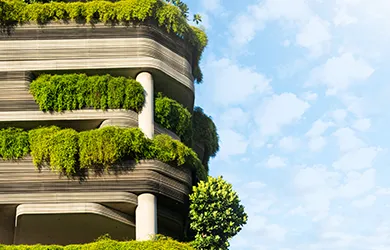- Our Story
- Our Impact
-
Our Projects
Residential
Commercial
- Careers
How to build greener, smarter cities
By LODHA
April 18, 2023The new-born city of Palava in India shows how to create conurbations with lower environmental impact, reports Science Director Roger Highfield.
A new city is under construction in India just a short distance away from the 20 million citizens of Mumbai, along with the urban sprawl's traffic congestion, toxic air, and water pollution.
Called Palava, it is a smart city that has been gradually taking shape on a greenfield site near Mumbai since 2008 and currently sees something like 50 high rise buildings built annually. Already home to 200,000 residents, Palava will ultimately have a population of more than a million.
The world economy is set to double from 2016 to 2050, while India's share of global GDP is projected to overtake that of the United States, so city designers in India can take advantage of innovations that optimize energy performance, water use and mobility.
They hope to show how to meet the demands of the 68 percent of the world's population who are projected to live in urban centres by 2050, and to do so in a way that mitigates the impacts of cities on the environment and the climate.
In 2018 the developers, India's Lodha, partnered with the US Rocky Mountain Institute to help develop a net zero roadmap for this smart city, a landmark in the evolution of what it sees as the city of the future.
The partnership has grown over the years and has now resulted in the formation of the Lodha Net Zero Urban Accelerator that aims to create an 'urbanization template' - with Palava as the living lab - to pave the way for responsible urban growth in India and the global south.
'This unique Accelerator aims through collaboration, integrative design, and efficiency to demonstrate that it is possible to decouple growth from emissions,' says Brett Bridgeland of the Rocky Mountain Institute, India. 'A climate resilient net zero Palava can be a lighthouse of urbanization for India and the world.'
DECARBONIZATION
The Accelerator developed its roadmap towards green cities by first focusing on the emissions related to construction, namely those linked with the materials that make up Palava's buildings, primarily cement, concrete, steel, glass, aluminium, other metals, plastics, wood and so on. These emissions can be reduced by using greener materials and efficient design strategies.
Then there are emissions made as the city goes about its business and these 'demand side emissions' can be reduced by using pumps, elevators, air conditioners and lights that are efficient and, of course, renewable sources of power. In addition, the designers wanted the city to be green and walkable to both cut emissions and benefit the health and wellbeing of its citizens.
Intelligently designed passive elements that enhance natural ventilation and daylight are also being used to offer Palava's citizens comfortable temperatures without the need for air conditioners, along with novel passive features that are being tested such as highly reflective paints on façades and solar chimneys - which exploit how hot air rises - to improve ventilation.
Palava's residents already have more than 4MWp installed capacity of solar photovoltaic panels on the city's rooftops and each building is also equipped with solar water heaters that cut the need for fossil-fuel based energy from the grid. They hope that all buildings in Palava will be equipped with enough solar panels to offset 100% of common area energy needs of the communities and the city is also working on developing community solar farms in the future.
As a result, the developers have been able to develop a city that has a residential energy use intensity as low as 35-40kWh per square metre and they are on a path towards 25kWh per square meter. 'We intend to publish details of this urban model for the benefit of the entire ecosystem of developers and policymakers,' says Brett Bridgeland.
From the beginning, Palava was planned with 25% green spaces, along with open spaces, so there are 8 sqm per person, which is four times more than the average in the Mumbai Metropolitan Region. The designers have ensured schools, offices, club houses, sporting arenas, green spaces, retail areas and so on are all no more than 15 minutes away by foot.
The city has been designed with wide pedestrian friendly walkways, shared bike stands, functional EV charging infrastructure, public buses within the city and outside to transit stations and commercial hubs, reducing the needs of personal car travel.
RESILIENCE
Because current emission commitments hardly limit the global temperature rise to 3°C above pre-industrial levels, double the 1.5 degrees sought in the Paris Climate Agreement, along with the latest gloomy assessment by the UN body assessing the science of climate change, the city designers have taken into account forecasting to ensure Palava can cope with the impact of climate change.
The city's designers have undertaken a detailed physical climate risk study using global climate models to help design the city's 'building blocks', its neighbourhoods. Each new one is designed respecting the natural attributes from contours, to ground hydrology, to existing biodiversity to make Palava more resilient.
The city designers took a holistic view of city water management, for example, which meant dealing with downpours, water supply, and wastewater treatment and reuse, boosting efficiency while also reducing the energy and carbon footprint of the design. By cutting storm water runoff they could cut downstream flood risks, while enhancing ground water quality and channelling water into green spaces.
While Palava City is supplied by the regional water authority, city planners are in the early stages of developing local supplies to diversify the water supply to increase resilience. To reduce water consumption and the energy footprint of the water supply, 100 percent of greywater, which comes from sinks, baths, washing machines, and other appliances, and blackwater (which contains faeces, urine, water, and toilet paper) in Palava City is being treated and reused on-site for domestic needs like flushing and irrigation.
'Ambitious projects like Palava are what we need right now', said Aun Abdullah, Head of ESG, Lodha. 'If we can succeed, the hope is we can pass on a healthy and habitable planet to future generations.'
You may also like



 Enquire
Enquire
 Call
Call
 chat
chat
 Search
Search




